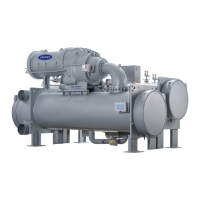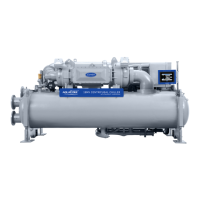68
Table 10 — Bolt Torque Requirements, Foot Pounds
Leak Test Chiller — Due to regulations regarding refrig-
erant emissions and the difficulties associated with separating
contaminants from the refrigerant, Carrier recommends the
following leak test procedure. Refer to Tables 11A and 11B for
refrigerant pressure/temperature values.
1. If the pressure readings are normal for the chiller
condition:
a. Evacuate the holding charge from the vessels, if
present.
b. Raise the chiller pressure, if necessary, by adding
refrigerant until pressure is at the equivalent satu-
rated pressure for the surrounding temperature.
Follow pumpout procedures in the Transfer Refrig-
erant from Storage Tank Vessel to Chiller section,
page 91.
c. Leak test chiller as outlined in Steps 3 - 9.
2. If the pressure readings are abnormal for the chiller con-
dition:
a. Prepare to leak test chillers shipped with refriger-
ant (Step 2h).
b. Check for large leaks by connecting a nitrogen bottle
and raising the pressure to 30 psig (207 kPa). Soap
test all joints. If the test pressure holds for 30 minutes,
prepare the test for small leaks (Steps 2g - h).
c. Plainly mark any leaks that are found.
d. Release the pressure in the system.
e. Repair all leaks.
f. Retest the joints that were repaired.
g. After successfully completing the test for large
leaks, remove as much nitrogen, air, and moisture
as possible, given the fact that small leaks may be
present in the system. This can be accomplished by
following the dehydration procedure, outlined in
the Chiller Dehydration section, page 71.
h. Slowly raise the system pressure to a maximum of
160 psig (1103 kPa) but no less than 35 psig
(241 kPa) for HFC-134a by adding refrigerant.
Proceed with the test for small leaks (Steps 3-9).
3. Check the chiller carefully with an electronic leak detec-
tor or soap bubble solution.
4. Leak Determination — If an electronic leak detector indi-
cates a leak, use a soap bubble solution, if possible, to
confirm. Total all leak rates for the entire chiller. Leakage
at rates greater than 0.1% of the total charge per year must
be repaired. Note the total chiller leak rate on the start-up
report.
5. If no leak is found during the initial start-up procedures,
complete the transfer of refrigerant gas from the pumpout
storage tank to the chiller. Retest for leaks.
BOLT SIZE
(IN.)
SAE 2, A307 GR A
HEX HEAD
NO MARKS
LOW CARBON STEEL
SAE 5, SA449
SOCKET HEAD OR HEX
WITH 3 RADIAL LINES
MEDIUM CARBON STEEL
SAE 8, SA354 GR BD
HEX HEAD
WITH 6 RADIAL LINES
MEDIUM CARBON STEEL
MINIMUM MAXIMUM MINIMUM MAXIMUM MINIMUM MAXIMUM
1
/
4
46 69913
5
/
16
811 13182028
3
/
8
13 19 22 31 32 46
7
/
16
21 30 35 50 53 75
1
/
2
32 45 53 75 80 115
9
/
16
46 65 75 110 115 165
5
/
8
65 95 105 150 160 225
3
/
4
105 150 175 250 260 370
7
/
8
140 200 265 380 415 590
1 210 300 410 580 625 893
1
1
/
8
330 475 545 780 985 1,410
1
1
/
4
460 660 770 1,100 1,380 1,960
1
3
/
8
620 885 1,020 1,460 1,840 2,630
1
1
/
2
740 1060 1,220 1,750 2,200 3,150
1
5
/
8
1010 1450 1,670 2,390 3,020 4,310
1
3
/
4
1320 1890 2,180 3,110 3,930 5,610
1
7
/
8
1630 2340 2,930 4,190 5,280 7,550
2 1900 2720 3,150 4,500 5,670 8,100
2
1
/
4
2180 3120 4,550 6,500 8,200 11,710
2
1
/
2
3070 4380 5,000 7,140 11,350 16,210
2
3
/
4
5120 7320 8,460 12,090 15,710 22,440
3 6620 9460 11,040 15,770 19,900 28,440
WARNING
Do not use air or oxygen as a means of pressurizing the
chiller. Mixtures of HFC-134a and air can undergo
combustion.
WARNING
Never charge liquid refrigerant into the chiller if the pres-
sure in the chiller is less than 35 psig (241 kPa) for HFC-
134a. Charge as a gas only, with the cooler and condenser
pumps running, until this pressure is reached, using
PUMPDOWN LOCKOUT and TERMINATE LOCK-
OUT mode on the PIC II. Flashing of liquid refrigerant at
low pressures can cause tube freeze-up and considerable
damage.

